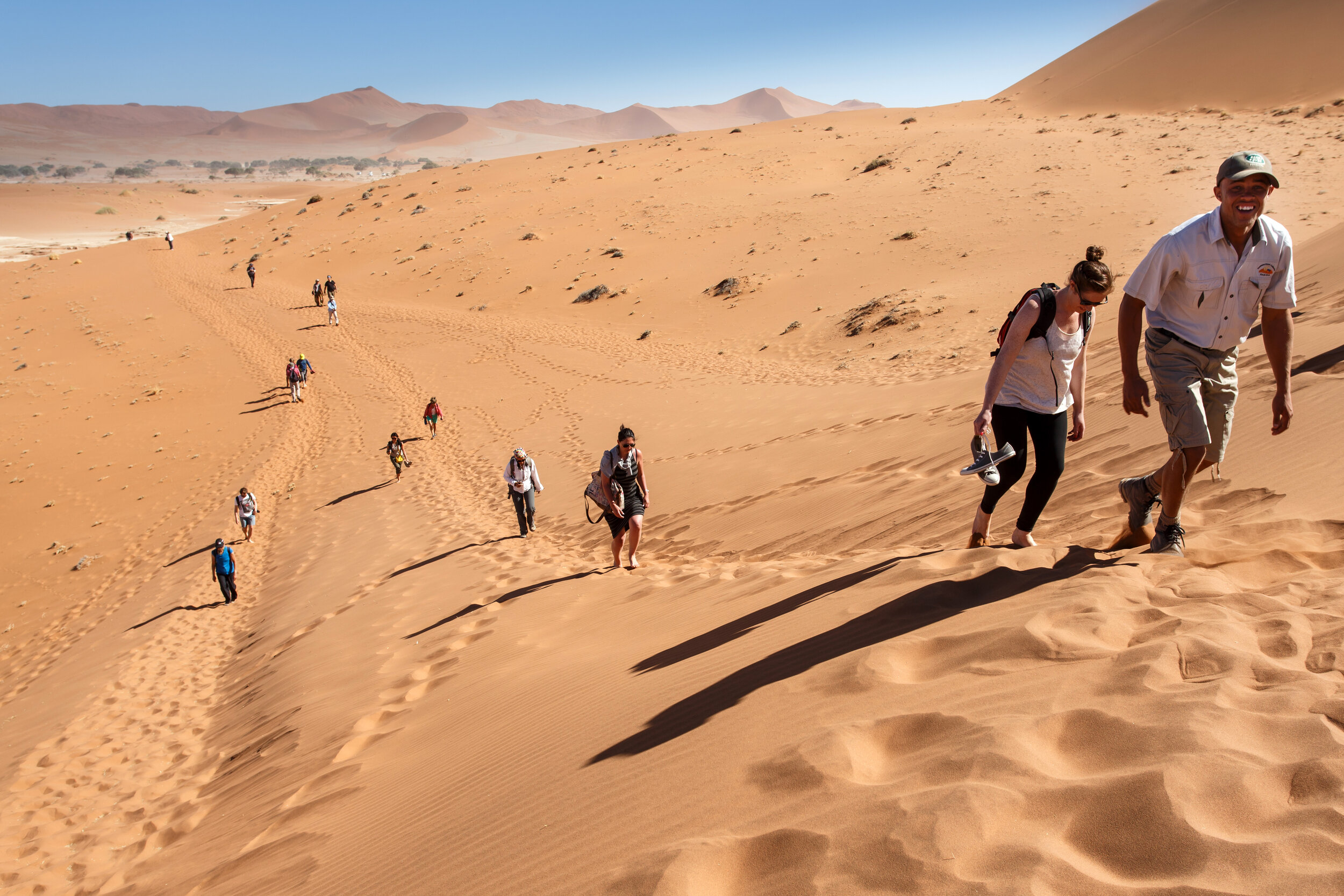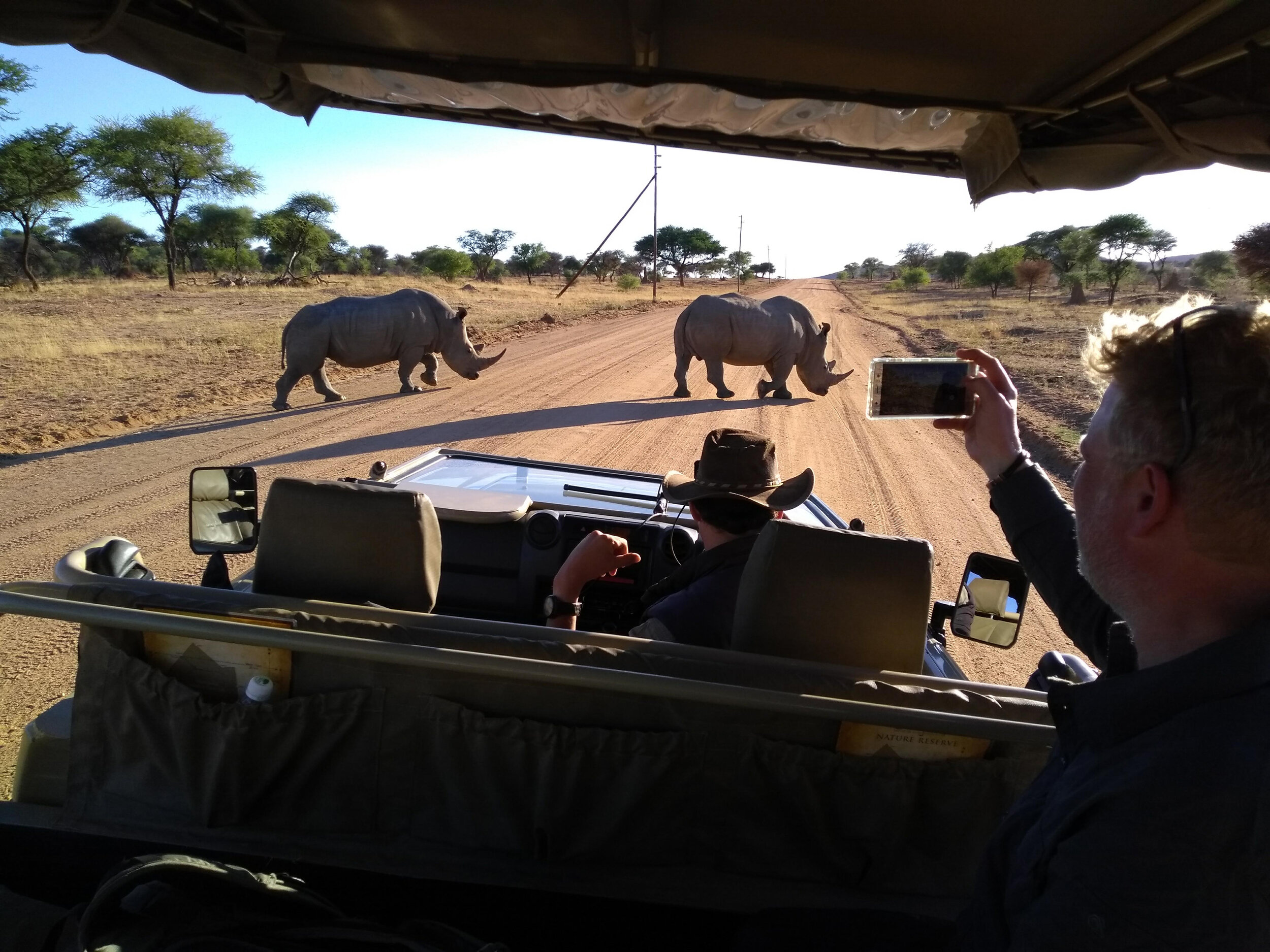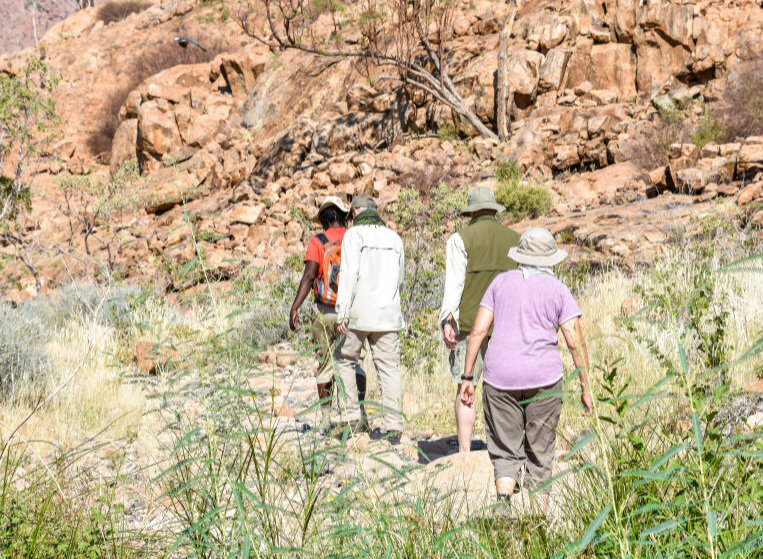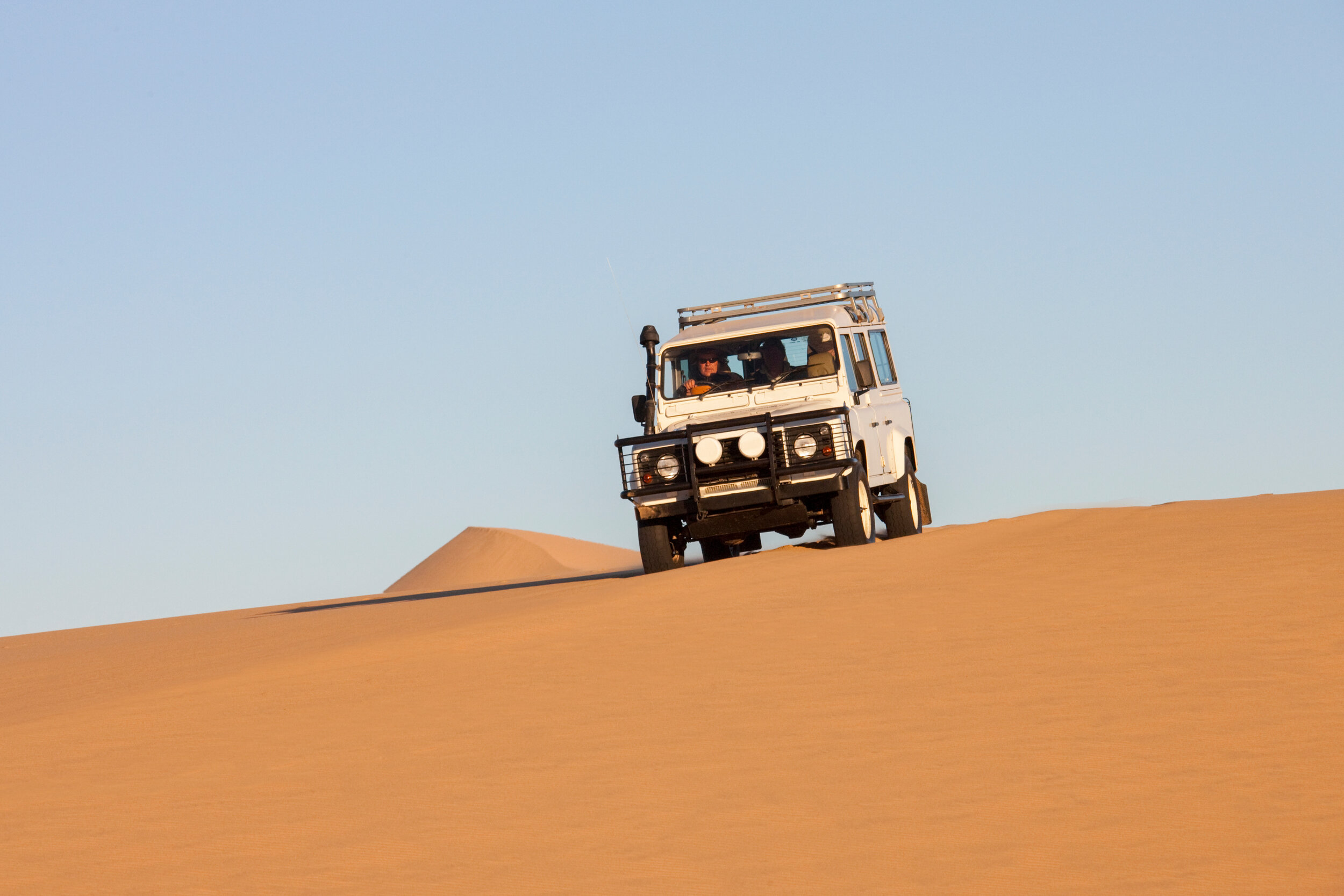The Complete Safari Guide to Namibia
Written by Daryll Williams
Vast, dry, and desolate, yet bursting with life. Desert abundance might seem like an oxymoron, but in Namibia, that phrase rings true. Here, desert-adapted elephants make epic journeys across expansive sands. Rhinos gather around salt pans. Black-manned lions survey their dusty kingdoms. And oryx can be found grazing around every corner – that’s also why their majestic horns adopted as the country’s symbol. It’s this inherent richness that makes Namibia one of the ultimate safari spots in all of Africa, managing to offer something for first-timers and experienced safari-goers alike.
African safaris: explained
The safari is one of the most sought after bucket-list items for modern-day travellers. And what once started as a hunting expedition has thankfully evolved into a more modern association of socially and environmentally responsible travel. Today, safaris are primarily overland journeys, embarked upon by a group who wish to observe wildlife in their natural environment. It’s a brilliant opportunity for budding photographers or for those who wish to get lost in the glory of the wilderness. In Namibia, however, the incredible wildlife is the central reason to go on safari.
Namibia safaris - where the wild things are
There’s very little that can truly prepare you for the sheer isolation of desert life. While the country can appear to be inaccessible because of its sweeping, vast landscapes, we believe that’s part of the appeal. Overall, a typical Namibia safari provides excellent wildlife and game (animals that used to be hunted for sport) viewing opportunities, mostly because life in the desert revolves around water. Animals must cluster close to where water remains, and as such, every Namibia safari focuses on waterholes, pans, or rivers. Find the water and you’ll find the animals, akin to something you’ll have seen in The Lion King as they gather around the few water sources available.
Types of safaris
It’s the range of experiences – that you don’t get elsewhere in Africa – which sets Namibia apart as a great destination. However, your safari style of choice will ultimately come down to the experience you want to have.
Guided safari
If its privacy and quality you’re after, a privately guided safari is the way to go. These safaris are done in the company of a dedicated and experienced safari guide, often assigned to you during your stay at a camp or lodge, who will ensure that you enjoy a fascinating and stress-free journey of discovery amidst dramatic scenery. And don’t worry about googling all the facts - your private guide will know them all by heart.
Self-drive safari
If you prefer to do things at your own pace, self-driving is the best way to take in Namibia’s beauty. You’ll pass the journey by spotting creatures of legend grazing on the plains, and be able to dictate your own guiding and tracking schedule.
Walking safari
If you’re after a much more immersive experience, walking safaris should be at the top of your list. These guided walks on the wild side are both awe-inspiring and humbling, as you tread along, led by a professional guide, through the very paths animals roam on freely and observe their lives from a careful distance. In fact, it is also one of the best ways to be guaranteed of animal sightings. The slow pace of the walk and the interpretive skills of the armed guides will open your eyes to a fascinating new world of wilderness.
Wildlife
This is the place to meet all of the Big 5 (elephant, lion, leopard, buffalo, and rhino). Along with herds of springbok and blue wildebeest, you can expect desert animals such as meerkat, ostrich and bat-eared foxes. Etosha is the best place in Africa to spot black rhino, while black-faced impala and Damara dik-dik are two other special species; they are only found in one other place – across the border in Angola.
Best places for safari
Etosha National Park stands toe to toe with Africa’s oft-lauded safari destinations, like Kruger National Park in South Africa, Chobe National Park in Botswana, and the Maasai Mara Reserve in Kenya. Etosha, in comparison, makes for an entirely unique experience, as the safari is entirely centred around spring-fed waterholes – you drive with your car from hole to hole. The end of the dry season sucks a procession of thirsty game from the parched bush. Zebra, giraffe, and others all jostling for position, giving way to boisterous elephant herds and black rhinos, while lion prides lurk in ambush. In the wet season, wildlife is less abundant and water is less scarce, however, you’ll see way more birdlife. Read more about this wildlife paradise in our complete guide to Etosha.
For off-the-beaten-track adventure with some thrilling wildlife sightings thrown in for good measure, Damaraland doesn’t disappoint. Located southwest of Etosha, it may not be as easily accessible as other areas in Namibia – you’ll need to have a 4x4 to explore the region’s rough roads – or as plentiful with wildlife as Etosha, but it offers a wilderness experience that you don’t find in many places in Africa anymore. Desert-adapted elephant, one of Africa’s largest free-ranging populations of critically endangered desert-adapted black rhino, and small pockets of lion roam these plains and rocky outcrops. Getting to see them move about freely against the startling backdrops is a far more exciting feeling than spotting game in a wildlife park.
The waters off Namibia’s northern coast are notorious for their strong currents, treacherous fog and shifting sandbanks, which have seen the demise of many ships, whales and other marine creatures over the centuries. This is the home of the Skeleton Coast. The golden beaches here could only be accessed, until recently, via a light-aircraft flight. And while it’s still worth taking a scenic flight over this coastal landscape, many of the sustainable lodges in the area now offer trips by road in a private vehicle. Guided game drives here take you through dry river valleys, where desert-adapted elephant, giraffe and hyena roam alongside gemsbok, kudu, springbok and jackals.
The Zambezi strip is Namibia’s fertile panhandle located in the furthest, most north-eastern corner of the country. It encompasses a surreal contrast to the remainder of the country’s wilderness. Forests and grasslands flourish as 4 of Africa’s great rivers take root, which manages to attract migratory herds throughout the dry season.
The Kalahari, Okonjima, Erindi, and NamibRand
Conversely, there’s good game viewing outside these more popular destinations too. Try the Kalahari Desert, and private game reserves like Okonjima Nature Reserve and Erindi. Game is a bit sparser in outlying deserts like in the NamibRand Nature Reserve, however, you should still be able to spot various antelope, zebra, and other creatures and critters like jackals. More often than not, you’ll find yourself wondering how on earth they manage to survive in such harsh environments.
Health & safety
Namibia is a safe, tourist-friendly country with excellent infrastructure despite its sparse habitation. As with any trip to a foreign country, some street sense will go a long way in ensuring you have the most pleasant stay possible. However, about the only place you will have to exercise usual safety procedures is Windhoek. Have a look at this safety index if you want to know more.
While there is a small risk of Malaria throughout the year (with peaks from November to June) in the north and northeastern regions of the country, there is low to no risk of Malaria throughout the vast majority of the country.
When on a guided safari, your guide will ensure your safety at all times – listen carefully to instructions and follow the park’s rules at all times. When on a self-drive safari, don’t drive too close to wildlife and only leave your car in designated areas where it is safe to do so.
Be aware that a typical trip to Namibia involves long driving distances in remote areas – you will often drive for hours without coming across a gas station or town. In essence, the only thing you should be concerned about is the potential for your car to break down in the desert. Check out our how to self-drive Namibia blog and sharpen up those tyre-changing skills.
FAQs about Namibia
We’ve taken the liberty to answer some of the most pressing questions we receive about travelling to Namibia.
Where is Namibia located?
Located south of the equator, where it borders Angola and Zambia in the north, Botswana in the east and South Africa in the south, Namibia’s landscape is versatile and marked by several characteristic regions. Furthermore, with a tiny population (just over 2 million) covering about the same landmass as France and Germany combined, the country manages to pack a lot of punch despite its pinch.
How do I get to Namibia?
When considering how to get to Namibia, by air is easiest. The country has two international airports, and with Walvis Bay only servicing a couple of South African cities, it’s likely you’ll land at Windhoek’s Hosea Kutako Airport. But you can also enter Namibia overland via South Africa, Botswana, Angola, or Zambia, or arrive by sea, if you’re so inclined.
Can I self-drive through Namibia?
Yes. You might have heard of self-driving adventures across this vast country before and they’re popular for a reason. By driving yourself you’ll have full control over your trip – choosing exactly where you want to go and how long you want to stay.
When is the best time to visit Namibia?
Namibia is a true year-round destination, with less extreme seasonal changes than other parts of Southern Africa, but it primarily experiences two distinct seasons: wet and dry. These seasons can completely transform the landscape, essentially dictating wildlife’s behaviour and your entire safari experience, as a result.
The dry season lasts from May to October. The lack of water brought on during this time means that animals have to gather around waterholes to drink, making them much easier to spot.
The wet season, which runs from October to April, experiences far fewer tourists, is less expensive, and sees the landscape transform into a lush kaleidoscope of vivid greens during this time, essentially making it harder to spot wildlife. However, rains usually arrive in short bursts, so it shouldn’t affect your trip too much. Read the Best Time to Travel to Namibia.
Insider tips
Get a car with air-conditioning - opening the windows might let in some fresh air, but it brings a lot of dust with it
Data coverage can be tricky at times. Make sure to download your Google Maps areas beforehand. Plus don't forget a good road trip playlist and download it for offline listening in advance
Several great attractions are found in the country’s many reserves. As there are some low costs attached to entry, have some cash on hand
The tap water is perfectly safe to drink, although it may taste a little different than what you’re used to
What are you waiting for?
Namibia overflows with sweet scenery, breathtaking beauty, and prolific concentrations of wildlife. As such, it’s easy to see why the country has become a top choice for travellers over recent years: Dig a little deeper, and you’ll always be surprised by what you find. For all its emptiness, the country remains a remarkably beautiful place to explore, where even a short stay is sure to be an epic one.
So what are you waiting for? Subscribe to our newsletter and be the first to know more.














